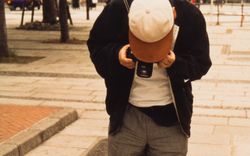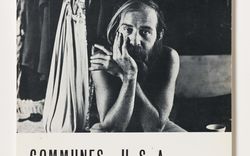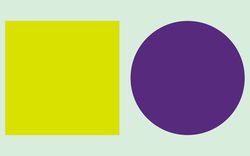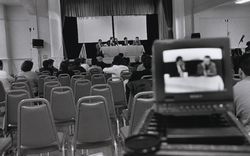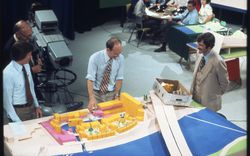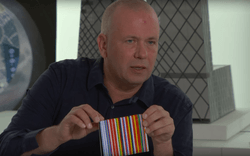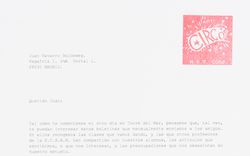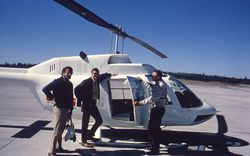A Loft, Aloft: John Hejduk at the Cooper Union
Text by Gary Fox
“LOFT SPACE”—on his personal letterhead, among thumbnail sketches for a reimagined Cooper Union, John Hejduk jots the phrase in his characteristic all-caps pen.
“CITY ON THE HILL”—elsewhere on the page, Hejduk pens this phrase in a similar hand, the words askew, almost as if performing their meaning. Hejduk’s city, circa 1970, was a take on John Winthrop’s 1630 “city upon a hill,” a metaphor calling upon the future British colony at Massachusetts Bay to serve as a beacon of morality. “The eyes of all people are upon us,” the Puritan professed, referencing the Sermon on the Mount. A trope of political oratory well into the twentieth century, Winthrop’s metaphor provided politicians on both the left and the right with a convenient shorthand for American exceptionalism, alluding to the country’s self-appointed role as democratic exemplar on the world stage. But Hejduk’s exceptionalism was not of the moral or the nationalistic sort—his was of the architectural variety.
Hejduk had graduated from Cooper Union twenty years earlier, in 1950, and returned there to teach in 1964. By the following year he was the Head of the Department of Architecture, and by 1970 he had begun a redesign of the school’s brownstone building. Wracked with structural issues and fire-code compliance problems, the building was reduced to a shell: “It was decided,” Hejduk writes, “to take most of the building’s insides out and put a new building inside.”1 An armature of vertical trusses outside held the shell upright, leaving Hejduk just about free to construct his city on the hill within.
Read more
-
John Hejduk, in Schools of Architecture, ed. Bart Goldhoorn (Rotterdam: NAi Publishers, 1996), 12. ↩
Already a National Historic Landmark, the sawn-off wedge of a building presented a fundamental planimetric challenge: no two sides of the four-sided building are parallel. To negotiate this formal constraint, Hejduk devised a dual system of orthogonal grids, one nearly twice the density of the other. The smaller grid, with its origin at the building’s southeast corner, organizes the school’s administrative offices and public circulation spaces; the larger, with its origin at the building’s northwest corner, organizes the school’s workshops, studios, laboratories, libraries, and classrooms. At no point do the systems align. Instead the grids collide at an obtuse angle, with their collision marked by a thick boundary establishing the threshold between public and private, between exhibition and instruction. Atop the composite grid system, Hejduk’s language of abstraction materializes in white plaster and grey tile: piers mark grid points and partitions suggest lines, all while the odd curvilinear panel defies any sense of rectilinearity.
Writing of the redesigned building in his retrospective Mask of Medusa, Hejduk remarked simply, “It’s a teaching device.” Hejduk’s building was to be a pedagogical instrument, and in that role not unlike his better-known teaching device, the nine-square problem: “And the students are here, working on that problem within this building, which is an example of that problem.”1 Caught in a pedagogical mise en abyme, students at Cooper Union were to benefit from a building conceived as an object lesson—a beacon—of architecture’s possibility, as much as they were to benefit from lessons taught within.
Hejduk is better known for the latter of these pedagogical strategies. In an effort to expand the discipline’s toolkit, Hejduk—as Head of the Department from 1965, as curricular Chairman in 1968, and as Dean of the School of Architecture from 1975—recruited a cast of eminent poets, playwrights, filmmakers, literary critics, and novelists to lead seminars, studios, and workshops at the school. Far less frequently noted is the fact that among these new hires was a robust lineup of experimental psychologists, sociologists, and cyberneticians, contributing in equal measure to this critical expansion. Prominent among these was John Zeisel, a sociologist who promoted the use of observational studies in research and taught a seminar entitled “Behavioral Science in Architectural Practice” in the late 1970s. Hejduk also hired the researcher Allen Wallis to teach the two-semester course “Introduction to Environmental Psychology” and an elective, “Planning of Community,” which dealt with “theories in the social sciences which attempt to account for community behavior and predict or control its changing character.” During the same period, the “empirically oriented” “Modern Classics in the Social Sciences” replaced “World Literature” as a required course in architecture’s core curriculum; the electives “Socio-Technological Studies,” “Psychology: Learning and Behavior,” “Psychology of Intelligence and Creativity,” and “Social Psychology”—which foregrounded “experimental research” on “heredity and the environment”—came in later years. The likes of the psychologist Judith Sills, the cybernetician Ranulph Glanville, the parapsychologist Stanley Krippner, and social researchers Sharon Garman Pavlovich, Leo Kaplan, and David Koch led courses at Cooper.2 All were committed to a notion that behaviour was radically dependent on the environment.
This sort of positivist behaviourism is not typically associated with Hejduk. His interest in psychology is well established, to be sure, but that interest was more clearly of the Freudian sort, often revealing itself in forms of narrativity, unconscious affiliation, and participatory fiction. On his personal letterhead, Hejduk collides these epistemological frameworks—the psychoanalytical and the behavioural.
The “CITY ON THE HILL” is a Freudian dream; registered amid sketches for a new building, the dream alludes to a romantic yet colonial fiction, recurrent yet repressed. At first blush, “LOFT SPACE” appears incongruous. But in the immediately preceding years, New York artists had begun to colonize disused loft spaces in neighbouring SoHo, a practice which was later legally enacted with the artist-in-residence zoning law of 1977. In his 1970 compendium to Cooper’s redesign, Hejduk argued that “industrial loft space”—“dear to the hearts of architects, planners, Peter Cooper buffs, and anybody who is continuously amazed by the foresight and ingenuity of the Nineteenth Century problem solvers and visionaries”—promised the possibility of “unlimited versatility” necessary to accommodate “the organic nature of a school.”3 The building was emphatically not “a monument” but rather a loft uniquely capable of promoting a new model of educational openness.4 Increasingly a signifier for creativity in this period, the loft as a type was not simply a space in which creativity happened but also a space that was thought to produce creativity itself.5 Nothing if not an allusion to the kind of behavioural possibilities that Wallis and his colleagues were advancing, the words “LOFT SPACE” sitting at the edge of the page stand in for the idea that architectural form might be congruent with its moral effect, that the building might be an instrument to make a certain type of individual out of its user. “LOFT SPACE” makes the “CITY ON THE HILL” possible.
In Hejduk’s hand, the Cooper Union building becomes a beacon for the possibility of architecture to condition behaviour. As if to literalize this sort of behavioural exceptionalism, Hejduk sketches a fantasy city atop the building, never to be realized. If the excess of pen deposited there is any evidence, Hejduk’s rhetoric translates directly to ink. Ink translates to built form, and built form translates to behaviour. This is Hejduk’s dream.
-
John Hejduk, Mask of Medusa: Works, 1947–1983 (New York: Rizzoli International Publications Inc., 1985), 70. ↩
-
Ulrich Franzen, Education of an Architect, a Point of View (New York: MoMA, 1971); John Hejduk, et al., eds., Education of an Architect (New York: Rizzoli International Publications, Inc., 1988); Ulrich Franzen, Kim Shkapich, and Alberto Pérez-Gomez, Education of an Architect: a Point of View the Cooper Union School of Art & Architecture 1964–1971 (New York: Monacelli Press, 1999); Cooper Union Course Catalogs and Course Descriptions, Cooper Union Archives. ↩
-
John Hejduk, Cooper Union Renovation Project, 1970, 3. ↩
-
Ibid., 1. ↩
-
Sylvia Lavin, “Creative Space,” Seminar, University of California, Los Angeles, Winter 2014. See also Sharon Zukin, “The Creation of a ‘Loft Lifestyle,’” in Loft Living: Culture and Capital in Urban Change (Baltimore: Johns Hopkins Press), 58–81. ↩
Gary Fox was here for a research residency in 2016, as part of our Doctoral Students Program.
